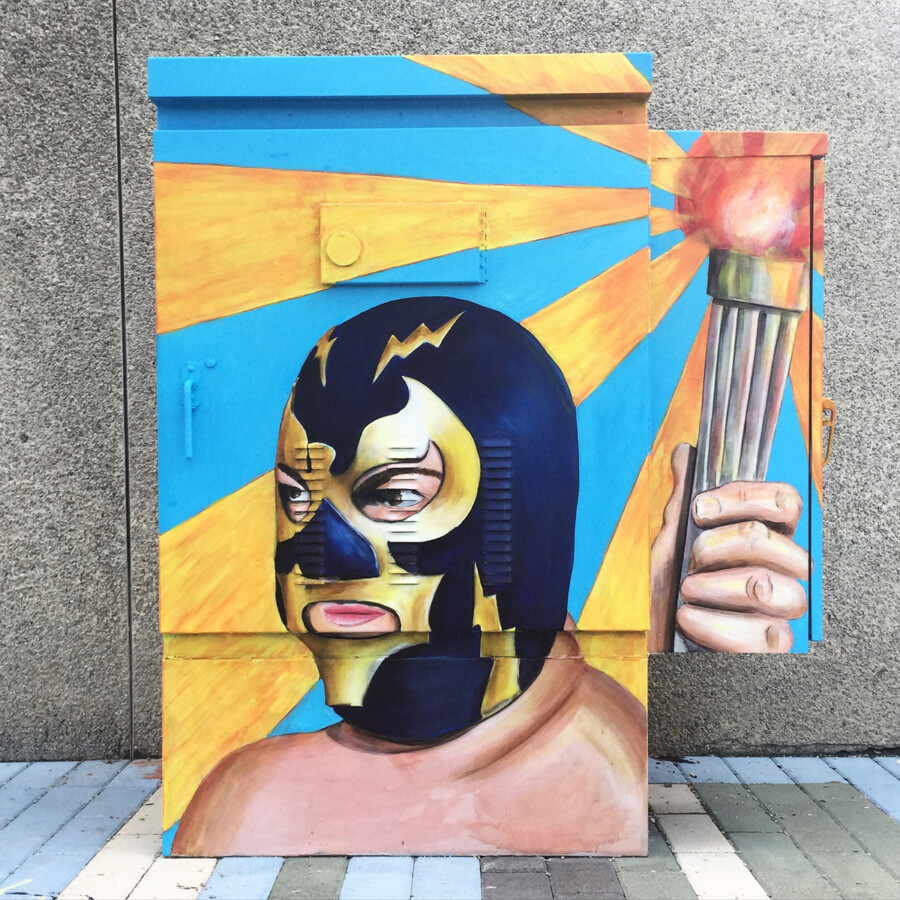Masked figures soar through the air, colliding with each other like acrobats on steroids. Vortexes of energy, the figures twist, tumble, duck, and brawl. Every day in the gym, they train for this fight. They were born for this fight. They dreamed of this fight as they watched their fathers and mothers battle other luchadores and luchadoras in the ring. The crowd explodes with each maneuver. And gasps of relief echo throughout the rafters. On this night, both the technicos and the rudos survive. The legendary fighters have once again left their mark.
These masked figures are not comic book superheroes or paid actors. They are luchadores and luchadoras, wrestlers in the one-hundred-year-old free-form style of professional Mexican wrestling Lucha libre. Renowned in Mexican culture, this sport is gaining acclaim in the United States, perhaps coinciding with the increasing numbers of Hispanics living here—a rise more significant than any other demographic increase in the history of this country.
During a match, the luchadores and luchadoras wear colorful masks and costumes that envisage their identity as technicos (good) or rudos (bad). A good-versus-bad story is then played out in the ring, hinting back to ancient Aztec and Mayan traditions. This battle might be experienced by the crowd as a choreographed, acrobatic dance, but the sport itself is no joke. The consequences of the duel can be grave, and more than one luchador has lost his life during a match.
Luchadores and luchadoras fight with passion and honor, as this dangerous art is often passed down from generation to generation. Many children grow up dreaming of becoming this fighter-superhero. They train in neighborhood gyms, placing their hearts, souls, blood, and sweat into the regimen. Indeed, for many fighters, fully embracing the identity and achievement of the luchador/luchadora is the primary life concern. Some of the wrestlers hide their true identities from the public eye by wearing their masks wherever they go. To these men and women, the masked identity—the celebrity—is often of greater significance than the individual behind the mask. Inherent in this identity shift is a form of personal transformation and escape that is then celebrated by the public. Indeed, luchadores and luchadoras are so widely treasured that they have been known to star in television and film, fulfilling such prescribed roles as rescuing the damsel in distress from an evil villain.
On a progressive note, the sport also leans to the side of inclusivity. Lucha libre offers platforms for both male and female wrestlers, as well as those who are tall and small, to contend. The ring is a place for everyone who seeks to dedicate his or her self entirely to the demands of training, labor, athleticism, showmanship, honor, and celebrity. It is also a sport that is publicly celebrated across generations, from toddlers to seniors.
The degree of inclusivity, the passion, the storytelling, the identity transformation, the rich history within Mexican culture—these are the reasons that artist Gerald Lopez finds intrigue with this sport and why Lucha libre is a primary influence in his visual art work. Lopez is a contemporary Mexican-American artist and art instructor whose paintings, mixed media, and public works stylistically incorporate allusions to Mexican folk art and Lucha libre while also considering themes of appropriation and personal imagination.
The images selected for this issue of The Other Journal highlight the colorful masks that are characteristic of the wrestlers, revealing insight into their masked personas. The titles of the pieces also offer clues into the characters of these painted figures, such as Prometheus—who in ancient Greek mythology stole fire from Mount Olympus and passed it along to humankind—which Lopez painted on a metal power box on a street in Corpus Christi, Texas. Or El Amante (The Lover), whose mask carries a gentler, sultry aesthetic of animal print and is shown in front of a modernized Mexican tile mosaic background—one way we see Lopez approach the aesthetic of Mexican folk art in his work. Another such blend of culture is found in El Catrin (The Gentlemen) and El Valiente, two works that are part of a large public mural, Lotería!, in downtown Corpus Christi. The mural, which was created from the contributions of over thirty artists, puts a contemporary spin on a Mexican game of chance that is similar to a game many of us know as bingo.
By painting images that represent the Mexican fighters of Lucha libre, Lopez iconizes the art of the masked superhero and plays with the fantasy that this alter-ego identity of the superhero-fighter could be available to us all. Not only is his work personal in its connection to his heritage, but it is also timely in that it reflects the growing popularity of this spectacle sport within the United States and the demographic changes that may be related to that growth in popularity. Although we may each approach Lucha libre and the art of Gerald Lopez through different cultural lenses, we include these pieces in this issue with the hope that we all might recognize the significance of cultural influence beyond our own and the uniqueness of art to bring us into shared experience and dialogue with one another. ¡Larga vida a la pasión del luchador! (Long live the passion of the luchador!)
